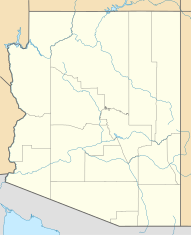Ventana Cave
| Ventana Cave | ||
|---|---|---|
| National Register of Historic Places | ||
| National Historic Landmark | ||
|
Ventana Cave |
||
|
|
||
| location | Tohono O'odham Nation Reservation , Pima County , Arizona | |
| Coordinates | 32 ° 21 ′ 0 ″ N , 112 ° 14 ′ 0 ″ W | |
| NRHP number | 66000189 | |
| Data | ||
| The NRHP added | October 15, 1966 | |
| Declared as an NHL | 20th January 1964 | |
Ventana Cave is an archaeological site located in Arizona on the Tohono O'odham Nation Reservation . On January 20, 1964, it was declared a National Historic Landmark . On October 15, 1966, the site was added to the National Register of Historic Places .
The cave was excavated by Emil Haury and Julian Hayden in 1941/42 . The finds lay under a layer of volcanic deposits. It is a horse from the Pleistocene , an extinct pronghorn species, one species each from the tapirs and sloths, and a few more.
Comparisons were made with the Folsom culture and the Clovis culture , but the new name Ventana Complex was chosen due to remaining specifics. The radiocarbon method pointed to a time around 11,300 BC. Chr.
A stratigraphy was carried out by Bruce Huckell and Vance Haynes between 1992 and 1994 and found that the volcanic material was between 10,500 and 8,800 BC. Was deposited. These researchers rejected the hypothesis put forward by the previous researchers that the animals were killed by stone tools, and attributed the flaw in the rejected hypothesis to the fact that vertical disturbance occurred after the deposition of the volcanic material.
literature
- EW Haury: The stratigraphy and archeology of Ventana Cave. Tucson: University of Arizona Press 1950.
Individual evidence
- ↑ Listing of National Historic Landmarks by State: Arizona. National Park Service , accessed July 20, 2019.
- ^ Ventana Cave on the National Register Information System. National Park Service , accessed July 29, 2017.

